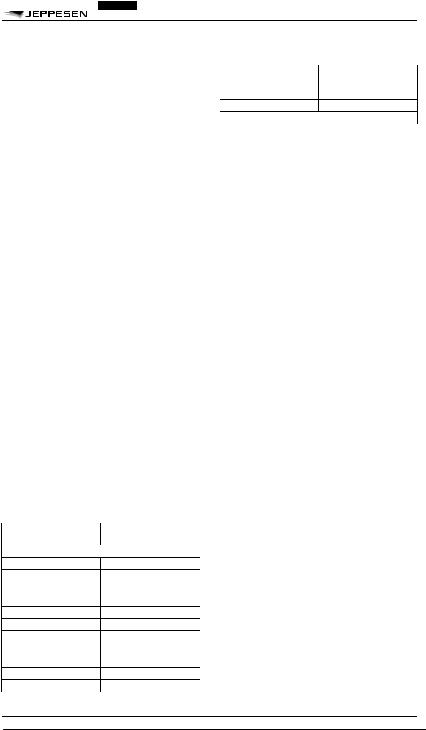
AIR TRAFFIC CONTROL
.pdf
16 APR 10 AIR TRAFFIC CONTROL |
613 |
EU-OPS 1 AERODROME OPERATING MINIMUMS (AOM)
JAR-OPS does not use the term CMV for converted meteorological visibility.
JAR-OPS does not include non-standard minimums for CAT I or CAT II precision approaches.
JAR-OPS does not include APV minimums but JAR-OPS 1 operators may be approved to conduct APV operations.
18.2TAKE-OFF MINIMUMS
The Take-off minimums are the same as for the EU-OPS. JAR-OPS 1 operators can use both, Standard and JAR-OPS Take-off minimums.
18.3CIRCLE-TO-LAND MINIMUMS
The Circling minimums are nearly the same as for the EU-OPS. The only difference is that JAR-OPS does not include the requirement that MDH and VIS must not be below the values of the preceding instrument approach procedure. JAR-OPS 1 operators can use both, Standard and JAR-OPS Circling minimums.
18.4NON-PRECISION APPROACH MINIMUMS
An operator must ensure that the MDH for a non-pre- cision approach is not below the OCH/OCL for the category of aircraft or the MDH values given in the Table 19 below.
Table 19 LOWEST MDH FOR NON-PRECISION APPROACHES – JAR-OPS
An operator must ensure that the RVR for a non-preci- sion approach is not below the values given in Table 20 below and not below any State given value. The table is only applicable to conventional approaches with a nominal descent slope of not greater than 4° (7.0%). Greater descent slopes will usually require
that visual glide slope guidance is also visible at the MDH. The figures may be either reported RVR or meteorological VIS converted to RVR as described in paragraph 5. The MDH in Table 20 refers to the initial MDH (before rounding).
Table 20 RVR FOR NON-PRECISION APPROACHES – JAR-OPS
© JEPPESEN, 1998, 2010. ALL RIGHTS RESERVED.

614 AIR TRAFFIC CONTROL 16 APR 10
EU-OPS 1 AERODROME OPERATING MINIMUMS (AOM)
18.5CAT I PRECISION APPROACH MINIMUMS
An operator must ensure that the DH for a precision approach is not lower than:
–The minimum DH specified in the operator’s flight operations manual,
–The minimum height to which the precision approach aid can be used without the required visual reference,
–The OCH/OCL for the aircraft category,
–200ft,
whichever is higher.
An operator must ensure that the RVR for a precision approach is not below the values given in the Table 21 below and not below any State given value. The table is only applicable to conventional approaches with a glide slope angle up to and including 4°. The figures may be either reported RVR or meteorological VIS converted to RVR as described in paragraph 5. The DH in Table 21 refers to the initial calculation of DH.
Table 21 RVR FOR CAT I PRECISION APPROACHES – JAR-OPS
18.6SINGLE PILOT OPERATIONS
For single pilot operations an RVR of less than 800m is not permitted, except when using a suitable autopilot coupled to an ILS or MLS, in which case normal minimums apply. The DH applied must not be less than 1.25x the minimum height for the autopilot.
18.7CAT II PRECISION APPROACH MINIMUMS
The CAT II minimums are the same as for the EU-OPS. JAR-OPS 1 operators can use both, Standard and JAR-OPS CAT II minimums.
18.8CAT III PRECISION APPROACH MINIMUMS
The CAT III minimums are nearly the same as for the EU-OPS. JAR-OPS 1 operators can use both, Standard and JAR-OPS CAT III minimums.
VISUAL REFERENCE
For CAT IIIA operations and for CAT IIIB operations with fail-passive flight control systems, a pilot may not continue an approach below the decision height unless a visual reference of one of the following elements is attained and can be maintained:
–at least 3 consecutive lights being the centerline of the approach lights,
–TDZ or CL or RL,
–or a combination of the above.
For CAT IIIB operations with fail-operational flight control systems using a decision height, a pilot may not continue an approach below the decision height unless a visual reference containing at least one centerline light is attained and can be maintained.
For CAT III operations with no decision height there is no requirement for visual contact with the runway prior to touchdown.
RVR
The Note 3 of Table 14 is not applicable to JAR-OPS 1 operators.
© JEPPESEN, 1998, 2010. ALL RIGHTS RESERVED.

Eff |
AIR TRAFFIC CONTROL |
A-1 |
12 SEP 08 |
REDUCED VERTICAL SEPARATION MINIMUM (RVSM) AFRICA
AFI RVSM AIRSPACE
Reduced Vertical Separation Minimum (RVSM) is vertical separation of aircraft by 1000ft between FL290 and FL410. With effect from 0001 UTC, 25 SEP 2008, only RVSM approved aircraft and State aircraft will be cleared to operate in the following FIRs:
Accra, Addis Ababa, Algiers, Antananarivo, Asmara, Beira, Brazzaville, Cairo, Canaries, Cape Town, Casablanca, Dakar, Dakar Oceanic, Dar es Salaam, Entebbe, Gaborone, Harare, Johannesburg, Johannesburg Oceanic, Kano, Khartoum, Kinshasa, Lilongwe, Luanda, Lusaka, Mauritius, Mogadishu, Nairobi, N’Djamena, Niamey, Roberts, Sal Oceanic, Seychelles, Tripoli, Tunis, Windhoek.
There is no transition airspace in entire AFI RVSM airspace.
AFI RVSM TRANSITION AIRSPACE
Transition tasks associated with the application of a 1000ft Vertical Separation Minimum (VSM) within the AFI RVSM Airspace shall be carried out in all, the adjacent FIRs/UIRs to the AFI RVSM airspace.
ATC units on the interface of AFI RVSM airspace shall:
–establish RVSM approved & non-RVSM approved State aircraft entering RVSM airspace at the appropriate RVSM FL;
–apply 1000ft VSM between RVSM approved aircraft, otherwise apply 2000ft RVSM;
Cruising levels as per direction of flight - FL280 to FL430 (continued)
FLIGHT OPERATIONS WITHIN THE AFI RVSM AIRSPACE
Except for State aircraft only RVSM approved aircraft shall be permitted to operate within the AFI RVSM airspace it should be noted that within the AFI RVSM airspace all cruising levels are equally assignable by ATC to all RVSM approved and State aircraft, provided that the applicable vertical separation minimum is applied.
ATC shall:
–only clear IFR RVSM approved aircraft & State aircraft into AFI RVSM airspace;
–provide a 1000ft VSM between RVSM approved aircraft;
–provide 2000ft VSM between all military formation flights and any other aircraft.
RVSM PROCEDURES
Only approved State aircraft shall be entitled to operate within the AFI RVSM Airspace, regardless of the RVSM status of the aircraft.
–establish non-RVSM approved civil aircraft below FL290 if landing at an aerodrome below the RVSM airspace;
–establish non-RVSM approved civil aircraft above
FL410 if transiting above the RVSM airspace & landing at an aerodrome outside AFI RVSM airspace;
–for aircraft leaving AFI RVSM airspace, apply 2000ft VSM and establish them at the appropriate non-RVSM levels.
ICAO TABLE OF CRUISING LEVELS FOR AFI RVSM AIRSPACE
Cruising levels as per direction of flight - FL280 to FL430
All operators filing Repetitive Flight Plans (RPLs) shall include in item Q of the RPL all equipment and capability information in conformity with item 10 of the ICAO flight plan.
Operators of RVSM approved aircraft shall indicate the approval status by inserting the letter “W” in item 10 of the ICAO Flight Plan, and in item Q of the Repetitive Flight Plan (RPL), regardless of the requested flight level.
Operators of non-RVSM approved State aircraft with a requested flight level of FL290 or above shall insert “STS/NONRVSM” in item 18 of the ICAO flight plan.
Operators of RVSM approved aircraft and non-RVSM approves State aircraft intending to operate within the AFI RVSM Airspace shall include the following in item 15 of the ICAO flight plan:
a.the entry point at the lateral limits of the AFI RVSM Airspace, and the requested flight level for that portion of the route commencing immediately after the RVSM entry point; and
b.the exit point at the lateral limits of the AFI RVSM Airspace, and the requested flight level for that portion of the route commencing immediately after the RVSM exit point.
© JEPPESEN, 2008. ALL RIGHTS RESERVED.

A-2 |
AIR TRAFFIC CONTROL |
Ef |
12 SEP 08 |
REDUCED VERTICAL SEPARATION MINIMUM (RVSM) AFRICA
STATE AIRCRAFT OPERATING WITHIN AFI RVSM AIRSPACE
All State aircraft operating in AFI RVSM Airspace will be considered as non-RVSM MASPS compliant and therefore non-RVSM approved. Therefore, the VSM required between State and other traffic shall be 2000ft. State aircraft, i.e. military aircraft, might be exempted from AFI RVSM requirements and where applicable, the indication that a non-RVSM approved aircraft is a State aircraft should be displayed.
IN-FLIGHT CONTINGENCY PROCEDURES
An in-flight contingency affecting flight in the AFI RVSM Airspace pertains to unforeseen circumstances, which directly impact on the ability of one or more aircraft to operate in accordance with the vertical navigation performance requirements of the AFI RVSM Airspace.
–The pilot shall inform ATC as soon as possible of any circumstances where the vertical navigation performance requirements for the AFI RVSM Airspace cannot be maintained;
–In above mentioned case, the pilot shall obtain a revised air traffic control clearance prior to initiating any deviation from the cleared route and/or flight level, whenever possible. Where a revised ATC clearance could not be obtained prior to such a deviation, the pilot shall obtain a revised clearance as soon as possible thereafter;
–ATC actions will be based on the intentions of the pilot, the overall air traffic situation, and the realtime dynamics;
–Suspension of RVSM refers to a discontinuance of the use of a vertical separation minimum of 1000ft between RVSM approved aircraft operating within the AFI RVSM Airspace;
–A VSM of 2000ft shall be applied between all aircraft operating within the portion of the AFI RVSM Airspace where RVSM has been suspended, regardless of the RVSM approval status of the aircraft.
AIRSPACE USER REQUIREMENTS
According to the ICAO Regional Supplementary Procedures - Doc 7030/5, AFI Part 1, the following compliance requirements apply:
Except for State aircraft, Operators intending to conduct flights will require an RVSM Approval either from the State in which the Operator is based or from the State in which the aircraft is registered. To obtain such an RVSM approval, Operators will need to satisfy the said State:
a.That aircraft for which the RVSM Approval is sought have the vertical navigation performance capability required for RVSM operations through compliance with the criteria of the RVSM Minimum Aircraft Systems Performance Specifications (MASPS).
b.That they have instituted procedures in respect of continued airworthiness (maintenance and repair) practices and programs; and
c.That they have instituted flight crew procedures for operations in the AFI RVSM airspace.
NOTE: An RVSM approval is not restricted to a specific region . Instead, it is valid globally on the understanding that any operating procedures specific to a given region, in this case the AFI region, should be stated in the operations manuals or appropriate crew guidance.
HEIGHT MONITORING
Requirement for participation in the RVSM height monitoring program
The requirement for monitoring systems from the initial RVSM feasibility studies and associated guidance as developed by the ICAO Review of General Concept of Separation Panel (RGCSP), and is specified in ICAO Doc 9574, “Manual on implementation of a 300m (1000ft) Vertical Separation Minimum between FL290 and FL410 inclusive”.
MONITORING SYSTEMS
The AFI RVSM monitoring system consists of portable GPS Monitoring Units (GMUs), which collects the required data.
For aircraft operators, the primary contact for the AFI Monitoring Program will be the AFI RMA (ARMA). For the AFI RVSM program, the ARMA will support operators (and approval authorities) on any issue related to RVSM approval and monitoring. It is important for the ARMA to have an accurate record of a point of contact for any queries that might arise from ongoing height monitoring. Operators are therefore requested to include a completed ARMA Point of Contact details with their first reply to the ARMA. Thereafter there is no further requirement unless there has been a change to the details requested on the form.
RVSM APPROVAL
Meeting the pre-requisites for monitoring, i.e. satisfying the appropriate RVSM airworthiness requirements and institute procedures in respect of continued airworthiness (maintenance and repair) practices and programs is not sufficient for RVSM approval.
© JEPPESEN, 2008. ALL RIGHTS RESERVED.

Eff |
AIR TRAFFIC CONTROL |
A-3 |
12 SEP 08 |
REDUCED VERTICAL SEPARATION MINIMUM (RVSM) AFRICA
COMMUNICATION
CONTROLLER/PILOT PHRASEOLOGY
INFORMATION
Further information on the RVSM program is available on the AFI RVSM Web site: www.icao.int/esaf
For exchange of data on aircraft RVSM compliance status and for any information on the AFI RVSM approval and monitoring aspects, please contact:
ARMA |
|
Address: |
Private Bag X15 |
|
South Africa |
|
1622 |
Tel: |
+27 11 928 6506 |
Fax: |
+27 11 928 6420 |
E-Mail: |
afirma@atns.co.za |
Internet: |
www.atns.co.za |
For any further information on policy, planning and implementation issues for RVSM in the AFI RVSM area, please contact the:
AFI RVSM Program Office
ICAO Eastern and Southern Africa Office
Address: |
Limuru Road, Gigiri |
|
|
United Nations Accomodation |
|
|
Nairobi |
|
|
Kenya |
|
Tel: |
+254 |
20 7622-378 |
Fax: |
+254 |
20 7623-028 |
E-Mail: |
Apolo.kharuga@icao.unon.org |
|
© JEPPESEN, 2008. ALL RIGHTS RESERVED.

3 AUG 07 |
AIR TRAFFIC CONTROL |
E-1 |
REDUCED VERTICAL SEPARATION MINIMUM (RVSM) EUR
AREA OF APPLICABILITY
RVSM shall be applicable in that volume of airspace between FL290 and FL410 inclusive in the flight information regions (FIR/UIR).
AIRCRAFT EQUIPMENT
The minimum equipment list (MEL) fulfilling the MASPS consists of: (see JAA TGL6)
Two independent altitude measurement systems each equipped with:
–cross-coupled static/source system with ice protection if located in areas subject to ice accretion,
–display of the computed pressure altitude to the flight crew,
–digital encoding of the displayed altitude signals referenced to a pilot selected altitude for automatic altitude control and alerting, static source error correction.
One SSR transponder with an altitude reporting system in use for altitude keeping.
An automatic altitude alerting system. An automatic altitude control system.
MEANS OF COMPLIANCE
Except for State aircraft, operators intending to conduct flights within the volume of airspace where RVSM is applied shall require an RVSM approval either from the State in which the operator is based or from the State in which the aircraft is registered.
To obtain such an RVSM approval, operators shall satisfy the said State that:
a.Aircraft for which the RVSM approval is sought have the vertical navigational performance capability required for RVSM operations through compliance with the criteria of the RVSM minimum aircraft systems performance specifications (MASPS).
b. They have instituted procedures in respect of continued airworthiness (maintenance and repair) and programs, and
c.They have instituted flight crew procedures for operations in the EUR RVSM airspace.
NOTE 1: An RVSM approval is not restricted to a specific region instead. It is valid globally on the understanding that any operating proce-
dures specific to a given region in this case the EUR Region, should be stated in the operations manual or appropriate crew guidance.
NOTE 2: Aircraft that have received State approval for RVSM operations will be referred to as ‘RVSM approved aircraft’.
NOTE 3: Aircraft that have not received State approval for RVSM operations will be referred to as ‘non-RVSM approved aircraft’.
Guidance material of use to those involved in the initial achievement and continued maintenance of the height-keeping performance capability has been issued by ICAO under the title “Guidance Material on the Implementation of a 300m (1000ft) Vertical Separation Minimum (VSM) in the European RSM Airspace”.
Detailed technical guidance material on the airworthiness, continued airworthiness, and the operational practices and procedures for the EUR RVSM airspace is provided in the Joint Aviation Authorities “Administrative and Guidance Material, Section One: General, Part 3: Temporary Guidance Leaflet No. 6”.
Monitoring of flight operations in the EUR RVSM airspace shall be conducted to assess the continuing compliance of aircraft with the height-keeping performance requirements.
NOTE: Monitoring will be conducted in accordance with the appropriate material issued by ICAO. When notified, operators will be required to cooperate in the monitoring program.
INDICATION IN THE FLIGHT PLAN OF RVSM APPROVAL STATUS
Flight planning for RVSM approved aircraft and non-RVSM approved State aircraft.
Operation of RVSM approved aircraft shall indicate the approval status by inserting the letter ‘W’ in the item 10 of the Flight Plan, regardless of the requested Flight Level.
Operators of formation flights of the State aircraft shall not insert the letter ‘W’ in item 10 of the Flight Plan, regardless of the RVSM approval status of the aircraft concerned.
Operators of formation flights of State aircraft intending to operate within the EUR RVSM airspace as general air traffic (GAT) shall include STS/NONRVSM in the item 18 of the flight plan.
Operators of RVSM approved aircraft shall also include the letter ‘W’ in item Q of the RPL, regardless of the requested flight level. If a change of aircraft operated in accordance with an RPL results in a modification of the RVSM approval status in item Q, a modification message (CHG) shall be submitted by the operator.
© JEPPESEN SANDERSON, INC., 2002, 2007. ALL RIGHTS RESERVED.

E-2 |
AIR TRAFFIC CONTROL 3 AUG 07 |
REDUCED VERTICAL SEPARATION MINIMUM (RVSM) EUR
FLIGHT PLANNING REQUIREMENTS REGARDING RVSM ENTRY/EXIT CONDITIONS
One issue addressed following the Flight Plan analysis exercise is the requirement to enter the RVSM entry/exit point and the corresponding Requested Flight Level (RFL) with respect to flights planned to be in the descent phase to an aerodrome located close to the lateral limits of the EUR RVSM airspace.
It has been clarified that there is no ICAO requirement to indicate in Item 15 that the flight is in the descent to the destination aerodrome. It has also been determined that the indication of an “artificial” flight level at the RVSM entry/exit point is potentially confusing with regard to ICAO Radio Communication Failure procedures.
In view of the above considerations it has been decided that the requirement to insert the RVSM entry/exit points plus the RFL (and speed) for that portion of the route commencing immediately after the RVSM entry/exit point is still valid for flights in the departure phase or in cruising levels.
However for flights whose planned trajectory indicates that they will be established in the descent phase at the RVSM entry/exit points to an adjacent destination aerodrome, the following conditions in Item 15 shall apply:
a.The RVSM entry/exit point shall be included, and, where appropriate,
b.The co-located STAR.
c.There is no requirement to indicate a requested Flight Level (or speed) associated with the RVSM entry/exit point.
RVSM ENTRY/EXIT POINTS
Operators of non-RVSM approved State aircraft with a requested flight level of FL290 or above shall insert STS/NONRVSM in item 18 of the flight plan.
FLIGHT PLANNING FOR NON-RVSM APPROVED AIRCRAFT
Except for the operations within the EUR RVSM transition airspace.
Operators of non-RVSM approved aircraft shall flight plan to operate outside the EUR RVSM airspace.
Operators of non-RVSM approved aircraft intending to operate from a departure airport outside the lateral limits of the EUR RVSM airspace to a destination airport within the lateral limits of the EUR RVSM airspace shall include the following in item 15 of the flight plan:
–the entry point at the lateral limits of the EUR RVSM airspace, and
–a requested flight level below FL290 for that portion of the route commencing immediately after the entry point.
Operators of non-RVSM approved aircraft intending to operate from a departure airport to a destination airport, both of which are outside the lateral limits of
the EUR RVSM airspace, with a portion of the route within the lateral limits of the EUR RVSM airspace, shall include the following in item 15 of the flight plan:
–the entry point of the lateral limits of the EUR RVSM airspace and a requested flight level below FL290 or above FL410 for that portion of the route commencing immediately after the entry point, and
–the exit point at the lateral limits of the EUR RVSM airspace and the requested flight level for that portion of the route commencing immediately after the exit point.
AIR TRAFFIC CONTROL CLEARANCES INTO THE EUR RVSM AIRSPACE
Except for operations within the EUR RVSM transition airspace, only RVSM approved aircraft and non-RVSM approved State aircraft shall be issued an ATC clearance into the EUR RVSM airspace.
ATC clearance into the EUR RVSM airspace shall not be issued to formation flights of aircraft.
SEPARATION OF AIRCRAFT
VERTICAL SEPARATION
Between FL290 and FL410 inclusive, within the EUR RVSM airspace, the vertical separation minimum shall be:
–300m (1000ft) between RVSM approved aircraft,
–600m (2000ft) between non-RVSM approved State aircraft and any other aircraft operating within the EUR RVSM airspace,
–all formation flights of State aircraft and any other aircraft operating within the EUR RVSM airspace, and
–non-RVSM approved aircraft and any other aircraft operating within the EUR RVSM airspace.
ATC shall provide a minimum vertical separation of 600m (2000ft) between an aircraft experiencing a communication failure in flight and any other aircraft when both aircraft are operating in the EUR RVSM airspace.
SPECIAL PROCEDURES APPLICABLE IN DESIGNATED AIRSPACES
Provisions for the transition of aircraft to/from the EUR/RVSM airspace.
AREA OF APPLICABILITY
RVSM approved aircraft and non-RVSM approved State aircraft entering the EUR RVSM airspace from a non-RVSM environment in the transition airspace.
RVSM approved aircraft and non-RVSM approved State aircraft entering the EUR RVSM airspace from a non-RVSM environment shall be established at a flight level in accordance with:
–the table of cruising levels, as published in ICAO Annex 2, Appendix 3, and/or
–a flight level allocation scheme, if applicable, and/or
© JEPPESEN SANDERSON, INC., 2002, 2007. ALL RIGHTS RESERVED.

3 AUG 07 |
AIR TRAFFIC CONTROL |
E-3 |
REDUCED VERTICAL SEPARATION MINIMUM (RVSM) EUR
–as specified in an inter-area control center (ACC) letter of agreement.
Any changes from non-RVSM levels to RVSM flight levels shall be initiated by the first ACC/upper area control center (UAC) providing ATC service to the aircraft within the EUR RVSM airspace and shall be achieved before the aircraft passes the transfer of control point to the adjacent ACC/UAC, unless otherwise specified in an inter-ACC letter of agreement.
Aircraft entering a non-RVSM environment from the EUR RVSM airspace shall be established with the applicable vertical separation minimum.
The applicable vertical separation minimum shall be established by the last ACC/UAC providing ATC service to the aircraft within the EUR RVSM airspace and before the aircraft passes the transfer of control point to the adjacent ACC/UAC.
Such aircraft shall be established at a flight level in accordance with:
–the table of cruising levels, as published in ICAO Annex 2, Appendix 3, and/or
–a flight level allocation scheme, if applicable, and/or
–as specified in an inter-ACC letter of agreement.
NON-RVSM APPROVED CIVIL OPERATIONS
Non-RVSM approved aircraft operating from a departure airport outside the lateral limits of the EUR RVSM airspace with a destination airport within the lateral limits of the EUR RVSM airspace shall be cleared to a flight level below FL290.
Such flight level changes shall be initiated by the first ACC/UAC providing ATC service to the aircraft within the EUR RVSM airspace and shall be achieved before the aircraft passes the transfer of control point prior to the adjacent ACC/UAC.
Non-RVSM approved aircraft operating from a departure airport to a destination airport, both of which are within the lateral limits of the EUR RVSM airspace, shall be cleared to a flight level below FL290.
Non-RVSM approved aircraft operating from a departure airport within the lateral limits of the EUR RVSM airspace to a destination outside the lateral limits of the EUR RVSM airspace:
–shall be cleared to a flight level below FL290, and
–may be cleared to FL290 or above by the last ACC/UAC providing ATC service to the aircraft within the EUR RVSM airspace, and such flight level changes shall be achieved before the aircraft passes the transfer of control point to the adjacent ACC/UAC.
Non-RVSM approved aircraft operating from a departure airport to a destination airport, both of which are outside the EUR RVSM airspace, with a portion of the route within the lateral limits of the EUR RVSM airspace:
–shall be cleared to a flight level below FL290 or above FL410 by the first ACC/UAC providing ATC service to the aircraft within the EUR RVSM
airspace, and such flight level changes shall be achieved before the aircraft passes the transfer of control point to the adjacent ACC/UAC, in accordance with the flight level allocation system (FLAS), if applicable, and/or as specified in an inter-ACC letter of agreement, and
–may subsequently be cleared to a requested flight level within or through the EUR RVSM airspace by the last ACC/UAC providing ATC service to the aircraft within the EUR RVSM airspace, and such flight level changes shall be achieved before the aircraft passes the transfer of control point to the adjacent ACC/UAC.
EUROPEAN/NORTH ATLANTIC (NAT) INTERFACE - NON-RVSM AIRCRAFT
The State Authorities responsible for Body, Stavanger, Trondheim, Scottish, Shannon, London, Brest, Madrid and Lisbon FIRS may establish designated airspace within their FIRS for the purpose of transitioning non-RVSM approved aircraft operating to and from the NAT Region.
ACCs/UACs providing ATC service in before mentioned FIRS may clear such non-RVSM approved aircraft to climb or descend through RVSM airspace.
Climb or descents through RVSM airspace shall be achieved before the aircraft passes the transfer of control point to the adjacent ACC/UAC, if applicable, unless otherwise specified in an inter-ACC letter agreement.
FLIGHT PLAN
If the receiving unit has not received a flight plan, the sending ATC unit shall verbally inform the receiving unit whether or not aircraft is RVSM approved.
When an automated message does not contain the information filed in the item 18 of the flight plan relevant to RVSM operations, the sending ATC unit shall inform the receiving unit of that information by supplementing the ATC message verbally, using the term ‘NEGATIVE RVSM’ or ‘NEGATIVE RVSM STATE AIRCRAFT’, as applicable.
When a verbal coordination process is being used, the sending ATC unit shall include the information filed in item 18 of the flight plan relevant to RVSM operations at the end of the verbal estimate message, using the term ‘NEGATIVE RVSM’ or ‘NEGATIVE RVSM STATE AIRCRAFT’, as applicable.
When a single aircraft is experiencing an in-flight contingency that impacts RVSM operations, the associated coordination message(s) shall be supplemented verbally by a description of the cause of the contingency.
SPECIAL PROCEDURES FOR IN-FLIGHT CONTINGENCIES INVOLVING A LOSS OF VERTICAL
© JEPPESEN SANDERSON, INC., 2002, 2007. ALL RIGHTS RESERVED.

E-4 |
AIR TRAFFIC CONTROL 3 AUG 07 |
REDUCED VERTICAL SEPARATION MINIMUM (RVSM) EUR
NAVIGATION PERFORMANCE REQUIRED FOR FLIGHT WITHIN THE EUR RVSM AIRSPACE
An in-flight contingency affecting flight in the EUR RVSM airspace pertains to unforeseen circumstances that directly impact the ability of one or more aircraft to operate in accordance with the vertical navigation performance requirements of the EUR RVSM airspace as specified under “MEANS OF COMPLIANCE”.
Such in-flight contingencies can result from degradation of aircraft equipment associated with heightkeeping and from turbulent atmospheric conditions.
The pilot shall inform ATC as soon as possible of any circumstances where the vertical navigation performance requirements for the EUR RVSM airspace cannot be maintained.
In such cases, the pilot shall obtain a revised ATC clearance prior to initiating any deviation from the cleared route and/or flight level, whenever possible.
When a revised ATC clearance could not be obtained prior to such a deviation, that pilot shall obtain a revised clearance as soon as possible thereafter.
ATC shall render all possible assistance to a pilot experiencing an in-flight contingency. Subsequent ATC actions will be based on the intentions of the pilot.
The overall traffic situation and the real-time dynamics of the contingency.
DEGRADATION OF AIRCRAFT
EQUIPMENT - PILOT REPORTED
When informed by the pilot of an RVSM approved aircraft in the EUR RVSM airspace that the aircraft’s equipment no longer meets the RVSM MASPS as specified under “MEANS OF COMPLIANCE” ATC shall consider the aircraft as non-RVSM approved.
ATC shall take action immediately to provide a minimum vertical separation of 600m (2000ft) or an appropriate horizontal separation from all other aircraft concerned that are operating in the EUR RVSM airspace.
An aircraft rendered non-RVSM approved shall normally be cleared out of the EUR RVSM airspace by ATC when it is possible to do so.
Pilots shall inform ATC, as soon as practicable, of any restoration of the proper functioning of equipment required to meet the RVSM MASPS.
The first ACC/UAC to become aware of a change in an aircraft’s RVSM status shall coordinate with adjacent ACC/UACs as appropriate.
SEVERE TURBULENCE - NO FORECAST
When an aircraft operating in the EUR RVSM airspace encounters severe turbulence due to weather or wake vortex that the pilot believes it will impact the aircraft’s capability to maintain its cleared flight level, the pilot shall inform ATC.
ATC shall establish either an appropriate horizontal separation or increased minimum vertical separation.
ATC shall, to the extent possible, accommodate pilot requests for flight level and/or route changes and shall pass on traffic information as required.
ATC shall solicit reports from other aircraft to determine whether RVSM should be suspended entirely or within a specific flight level band and/or area.
SEVERE TURBULENCE - FORECAST
When a meteorological forecast is predicting severe turbulence within the EUR RVSM airspace, ATC shall determine whether RVSM should be suspended and, if so, the period of time and specific flight level(s) and/or area.
In cases where RVSM will be suspended, the ACC/UAC suspending RVSM shall coordinate with adjacent ACC/UACs with regard to the flight levels appropriate for the transfer of traffic, unless a contingency flight level allocation scheme has been determined by letter of agreement.
The ACC/UAC suspending RVSM shall also coordinate applicable capacities with adjacent ACC/UACs as appropriate.
CONTROLLER/PILOT PHRASEOLOGY
© JEPPESEN SANDERSON, INC., 2002, 2007. ALL RIGHTS RESERVED.

3 AUG 07 |
AIR TRAFFIC CONTROL |
E-5 |
REDUCED VERTICAL SEPARATION MINIMUM (RVSM) EUR
CONTROLLER/PILOT PHRASEOLOGY (continued)
© JEPPESEN SANDERSON, INC., 2002, 2007. ALL RIGHTS RESERVED.
